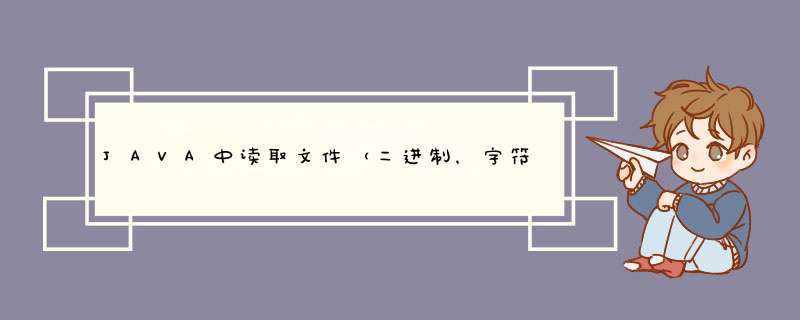
public class ReadFromFile {
/**
* 以字节为单位读取文件,常用于读二进制文件,如图片、声音、影像等文件。
*/
public static void readFileByBytes(String fileName) {
File file = new File(fileName)
InputStream in = null
try {
System.out.println("以字节为单位读取文件内容,一次读一个字节:")
// 一次读一个字节
in = new FileInputStream(file)
int tempbyte
while ((tempbyte = in.read()) != -1) {
System.out.write(tempbyte)
}
in.close()
} catch (IOException e) {
e.printStackTrace()
return
}
try {
System.out.println("以字节为单位读取文件内容,一次读多个字节:")
// 一次读多个字节
byte[] tempbytes = new byte[100]
int byteread = 0
in = new FileInputStream(fileName)
ReadFromFile.showAvailableBytes(in)
// 读入多个字节到字节数组中,byteread为一次读入的字节数
while ((byteread = in.read(tempbytes)) != -1) {
System.out.write(tempbytes, 0, byteread)
}
} catch (Exception e1) {
e1.printStackTrace()
} finally {
if (in != null) {
try {
in.close()
} catch (IOException e1) {
}
}
}
}
/**
* 以字符为单位读取文件,常用于读文本,数字等类型的文件
*/
public static void readFileByChars(String fileName) {
File file = new File(fileName)
Reader reader = null
try {
System.out.println("以字符为单位读取文件内容,一次读一个字节:")
// 一次读一个字符
reader = new InputStreamReader(new FileInputStream(file))
int tempchar
while ((tempchar = reader.read()) != -1) {
// 对于windows下,\r\n这两个字符在一起时,表示一个换行。
// 但如果这两个字符分开显示时,会换两次行。
// 因此,屏蔽掉\r,或者屏蔽\n。否则,将会多出很多空行。
if (((char) tempchar) != '\r') {
System.out.print((char) tempchar)
}
}
reader.close()
} catch (Exception e) {
e.printStackTrace()
}
try {
System.out.println("以字符为单位读取文件内容,一次读多个字节:")
// 一次读多个字符
char[] tempchars = new char[30]
int charread = 0
reader = new InputStreamReader(new FileInputStream(fileName))
// 读入多个字符到字符数组中,charread为一次读取字符数
while ((charread = reader.read(tempchars)) != -1) {
// 同样屏蔽掉\r不显示
if ((charread == tempchars.length)
&&(tempchars[tempchars.length - 1] != '\r')) {
System.out.print(tempchars)
} else {
for (int i = 0i <charreadi++) {
if (tempchars[i] == '\r') {
continue
} else {
System.out.print(tempchars[i])
}
}
}
}
} catch (Exception e1) {
e1.printStackTrace()
} finally {
if (reader != null) {
try {
reader.close()
} catch (IOException e1) {
}
}
}
}
/**
* 以行为单位读取文件,常用于读面向行的格式化文件
*/
public static void readFileByLines(String fileName) {
File file = new File(fileName)
BufferedReader reader = null
try {
System.out.println("以行为单位读取文件内容,一次读一整行:")
reader = new BufferedReader(new FileReader(file))
String tempString = null
int line = 1
// 一次读入一行,直到读入null为文件结束
while ((tempString = reader.readLine()) != null) {
// 显示行号
System.out.println("line " + line + ": " + tempString)
line++
}
reader.close()
} catch (IOException e) {
e.printStackTrace()
} finally {
if (reader != null) {
try {
reader.close()
} catch (IOException e1) {
}
}
}
}
/**
* 随机读取文件内容
*/
public static void readFileByRandomAccess(String fileName) {
RandomAccessFile randomFile = null
try {
System.out.println("随机读取一段文件内容:")
// 打开一个随机访问文件流,按只读方式
randomFile = new RandomAccessFile(fileName, "r")
// 文件长度,字节数
long fileLength = randomFile.length()
// 读文件的起始位置
int beginIndex = (fileLength >4) ? 4 : 0
// 将读文件的开始位置移到beginIndex位置。
randomFile.seek(beginIndex)
byte[] bytes = new byte[10]
int byteread = 0
// 一次读10个字节,如果文件内容不足10个字节,则读剩下的字节。
// 将一次读取的字节数赋给byteread
while ((byteread = randomFile.read(bytes)) != -1) {
System.out.write(bytes, 0, byteread)
}
} catch (IOException e) {
e.printStackTrace()
} finally {
if (randomFile != null) {
try {
randomFile.close()
} catch (IOException e1) {
}
}
}
}
/**
* 显示输入流中还剩的字节数
*/
private static void showAvailableBytes(InputStream in) {
try {
System.out.println("当前字节输入流中的字节数为:" + in.available())
} catch (IOException e) {
e.printStackTrace()
}
}
public static void main(String[] args) {
String fileName = "C:/temp/newTemp.txt"
ReadFromFile.readFileByBytes(fileName)
ReadFromFile.readFileByChars(fileName)
ReadFromFile.readFileByLines(fileName)
ReadFromFile.readFileByRandomAccess(fileName)
}
}
首先,可以直接写入string的,这段程序的这种写法很无聊,让你误解了。\x0d\x0a如:out.write(p_send_text)\x0d\x0a\x0d\x0a其次,如果想写入一行并且换行的话,那么得包装一个printwriter,如:\x0d\x0aPrintWriterout=newPrintWriter(FileWriter(file,true))\x0d\x0aout.println(p_send_text)\x0d\x0a\x0d\x0a在Java里,\x0d\x0achar表示一个字符,它可以直接转换为int,byte,long.(ascii/unicode码)\x0d\x0aString表示一串字符,它可以通过某些方法转换成一个数组,如char[],byte[],也可以用其他方法取出其中某个特定位置的字符,如charAt()\x0d\x0a\x0d\x0a与C里面不同,在Java中,通常String用的比较多,char[]基本不用的。欢迎分享,转载请注明来源:内存溢出

 微信扫一扫
微信扫一扫
 支付宝扫一扫
支付宝扫一扫
评论列表(0条)